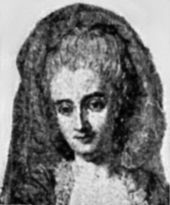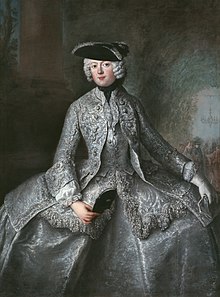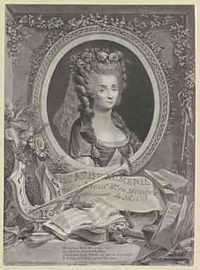women in music 3
Western composers[edit]
 This section needs additional citations for verification. Please help improve this article by adding citations to reliable sources in this section. Unsourced material may be challenged and removed.
This section needs additional citations for verification. Please help improve this article by adding citations to reliable sources in this section. Unsourced material may be challenged and removed.
Find sources: "Women in music" – news · newspapers · books · scholar · JSTOR (November 2022) (Learn how and when to remove this template message) Nineteenth-century composer and pianist Clara Schumann
Nineteenth-century composer and pianist Clara Schumann
See also: List of female composers by birth date
American musicologist Marcia Citron has asked "[w]hy is music composed by women so marginal to the standard 'classical' repertoire?"[41] Citron "examines the practices and attitudes that have led to the exclusion of women composers from the received 'canon' of performed musical works." She argues that in the 1800s, women composers typically wrote art songs for performance in small recitals rather than symphonies intended for performance with an orchestra in a large hall, with the latter works being seen as the most important genre for composers; since women composers did not write many symphonies, they were deemed to be not notable as composers.[41]
According to Abbey Philips, "women musicians have had a very difficult time breaking through and getting the credit they deserve".[42] During the Medieval eras, most of the art music was created for liturgical (religious) purposes and due to the views about the roles of women that were held by religious leaders, few women composed this type of music, with the nun Hildegard von Bingen being among the exceptions. Most university textbooks on the history of music discuss almost exclusively the role of male composers. As well, very few works by women composers are part of the standard repertoire of classical music. In the Concise Oxford History of Music, Clara Schumann is one of the only women composers mentioned.[42] Philips states that "[d]uring the 20th century the women who were composing/playing gained far less attention than their male counterparts."[42]
Medieval era[edit]

O frondens virga
Duration: 1 minute and 37 seconds.
1:37
From Ordo Virtutum
Problems playing this file? See media help.
Hildegard von Bingen (1098–1179) was a German Benedictine abbess, composer, writer, philosopher, and visionary.[43] One of her works as a composer, the Ordo Virtutum, is an early example of liturgical drama and an early morality play. Some writers have speculated a distant origin for opera in this piece, though without any evidence.[44][45] Sixty-nine musical compositions, each with its own original poetic text, survive. This is one of the largest repertoires among medieval composers. Hildegard composed many liturgical songs that were collected into a cycle called the Symphonia armoniae celestium revelationum. The songs from the Symphonia are set to Hildegard's own text and range from antiphons, hymns, and sequences, to responsories.[46] Her music is described as monophonic,[47] using soaring melodies that pushed the boundaries of the more traditional Gregorian chant.
Renaissance era[edit]
Maddalena Casulana (1544–1590) was an Italian composer, lutenist and singer.[48] Her first work dates from 1566: four madrigals in a collection, Il Desiderio, which she produced in Florence. Two years later she published in Venice her first book of madrigals for four voices, Il primo libro di madrigali, which is the first printed, published work by a woman in Western music history.[49] She was close to Isabella de' Medici and dedicated some of her music to her. In 1570, 1583, and 1586 she published other books of madrigals. In the dedication to her first book of madrigals, she shows her feelings about being a female composer at a time when this was rare: "[I] want to show the world, as much as I can in this profession of music, the vain error of men that they alone possess the gifts of intellect and artistry, and that such gifts are never given to women." Her style is contrapuntal and chromatic and her melodic lines are singable and attentive to the text. Other composers of the time, such as Philippe de Monte, thought highly of her.
Caterina Assandra (1590–1618) was an Italian composer and Benedictine nun. She became famous as an organist and published various works.[50][51] Assandra composed a number of motets and organ pieces. She studied counterpoint with Benedetto Re, one of the leading teachers at Pavia Cathedral. She composed a collection of motets in the new concertato style in Milan in 1609, an imitative eight-voice Salve Regina in 1611, and a motet, Audite verbum Dominum, for four voices in 1618. She composed traditional pieces and more innovative works. Among the latter is Duo seraphim. Her motet O Salutaris hodie, included in Motetti op. 2, was one of the first pieces to include the violone, a bowed stringed instrument.
Baroque era[edit]
 The Lute Player by Orazio Gentileschi, presumed to be a portrait of Francesca Caccini
The Lute Player by Orazio Gentileschi, presumed to be a portrait of Francesca Caccini
Francesca Caccini (1587–1641) was an Italian composer, singer, lutenist, poet, and music teacher. Her singing for the wedding of Henry IV of France and Maria de Medici in 1600 was praised by Henry, who called her the "best singer in all of France".[52] She worked in the Medici court as a teacher, chamber singer, rehearsal coach and composer of both chamber and stage music until 1627. By 1614 she was the court's most highly paid musician, because her musical virtuosity so well exemplified an idea of female excellence projected by Tuscany's de facto Regent, Granduchess Christina of Lorraine. Most of her stage music was composed for performance in comedies. In 1618 she published a collection of thirty-six solo songs and soprano/bass duets. In 1625 she composed a 75-minute "comedy-ballet." In all, she wrote sixteen staged works. She was a master of dramatic harmonic surprise: in her music it is harmony changes, more than counterpoint, that most powerfully communicates emotional affect.
Barbara Strozzi (1619–1677) was an Italian Baroque composer and singer. As a child, her considerable vocal talents were displayed to a wide audience. She was also compositionally gifted, and her father arranged for her to study with composer Francesco Cavalli. Strozzi was said to be "the most prolific composer – man or woman – of printed secular vocal music in Venice in the Middle of the century."[53] Her output is also unique in that it only contains secular vocal music, with the exception of one volume of sacred songs.[54] She was renowned for her poetic ability as well as her compositional talent. Her lyrics were often poetic and well-articulated.[53] Nearly three-quarters of her printed works were written for soprano, but she also published works for other voices.[55] Her compositions are firmly rooted in the seconda pratica tradition. Strozzi's music evokes the spirit of Cavalli, heir of Monteverdi. However, her style is more lyrical, and more dependent on sheer vocal sound.[56] Many of the texts for her early pieces were written by her father Giulio. Later texts were written by her father's colleagues, and for many compositions she may have written her own texts.
Élisabeth Jacquet de La Guerre (1665–1729) was a French composer, musician and harpsichordist. She was born into a family of musicians and master instrument-makers. A child prodigy, she performed on the harpsichord before King Louis XIV. She became a musician in the Royal Court and taught, composed, and gave concerts at home and throughout Paris, to great acclaim.[57] She was one of the few well-known female composers of her time, and unlike many of her contemporaries, she composed in a wide variety of forms.[58] Her talent and achievements were acknowledged by Titon du Tillet, who accorded her a place on his Mount Parnassus when she was only 26 years old, next to Lalande and Marais and directly below Lully. Her works include a ballet, an opera (Céphale et Procris), trio sonatas, harpsichord pieces, Sonates pour le viollon et pour le clavecin and vocal works such as her Cantates françoises sur des sujets tirez de l'Ecriture.
Classical era[edit]
 Swedish opera singer and composer Elisabeth Olin in the 1780s
Swedish opera singer and composer Elisabeth Olin in the 1780s This section needs additional citations for verification. Please help improve this article by adding citations to reliable sources in this section. Unsourced material may be challenged and removed. (January 2024) (Learn how and when to remove this template message)
This section needs additional citations for verification. Please help improve this article by adding citations to reliable sources in this section. Unsourced material may be challenged and removed. (January 2024) (Learn how and when to remove this template message)
Harriett Abrams (1758–1821) was an English composer and soprano. As a singer, she was praised for her performances of George Frideric Handel. She studied singing, music theory, and composition with composer Thomas Arne before making her opera début in 1775 at the Theatre Royal, Drury Lane in London. Abrams became a principal singer at the fashionable London concerts and provincial festivals, appearing regularly from 1780 to 1790. Abrams composed several songs, two of which, "The Orphan's Prayer" and "Crazy Jane", became popular. She published two sets of Italian and English canzonets, a collection of Scottish songs and glees harmonized for two and three voices, and more than a dozen songs, mainly sentimental ballads. A collection of songs published in 1803 was dedicated by Harriett to Queen Charlotte.[59]
Maria Teresa Agnesi (1720–1795) was an Italian composer. Though she was most famous for her compositions, she was also an accomplished harpsichordist and singer. The majority of her surviving compositions were written for keyboard, the voice, or both. Her career was made possible by the Austrian Lombardy, which was progressive and enlightened in women's rights. Her patron was Maria Theresia, holy Roman Empress and sovereign of Lombardy, and Maria Antonia Walpurgis, a gifted composer and contemporary. Her early works are simple and clean, while her later works are more virtuosic, complex, and melodramatic. She composed operas, including heroic drama and serious drama styles. She also wrote arias, concertos, and sonatas for keyboard, small ensemble and voice.
Princess Anna Amalia (1723–1787) was a Prussian composer and score curator. She learned to play the harpsichord, flute, and violin as a young woman. She became the Abbess of Quedlinburg in 1755.[60] She spent most of her time in Berlin, where she devoted herself to music, and became a musical patron and composer. As a composer, she achieved a modest amount of fame and is most known for her smaller chamber works, which included trios, marches, cantatas, songs and fugues. In 1758, she studied musical theory and composition with Johann Philipp Kirnberger, a student of Johann Sebastian Bach. She composed chamber music such as flute sonatas. Moreover, she set the text of Ramler's Passion cantata Der Tod Jesu ('The Death of Jesus') to music. She was also a collector of music, preserving over 600 volumes of works by Johann Sebastian Bach, George Frideric Handel, Georg Philipp Telemann, Karl Heinrich Graun and Carl Philipp Emanuel Bach, among others. Her works of curation are a significant contribution to Western culture. Princess Anna Amalia (1723–1787) was a Prussian composer and score curator known for her chamber works, which included trios, marches, cantatas, songs and fugues.
Princess Anna Amalia (1723–1787) was a Prussian composer and score curator known for her chamber works, which included trios, marches, cantatas, songs and fugues.
Elisabeth Olin (1740–1828) was a Swedish opera singer and composer. She debuted as Alfhild in Syrinx, referred to as Sweden's first native opéra comique, at Bollhuset in 1747. She became a famed vocalist in the regular public concerts at Riddarhuset in Stockholm, and published her own compositions; she was one of the Swedish composers who wrote one composition each for the collection Gustaviade. En hjältedikt i tolv sånger ('Gustaviade. A heroic poem of twelve songs') from 1768; where she wrote the composition number eight.[61] At the inauguration performance and foundation of the Royal Swedish Opera on 18 January 1773, she sang the role of the Sea Goddess Thetis in Francesco Uttini's opera Thetis och Pélée.[62] She remained the primadonna of the Swedish opera for a decade. In 1773, she became the first woman to be granted the title Hovsångare, and in 1782, she was inducted as the first female member of the Royal Swedish Academy of Music.[61] French composer and opera singer Henriette Adélaïde Villard de Beaumesnil
French composer and opera singer Henriette Adélaïde Villard de Beaumesnil
Henriette Adélaïde Villard de Beaumesnil (1748–1813) was a French composer and opera singer. She began working in minor comedy roles from the age of seven and debuted as a soloist at the Paris Opera in 1766.[63][64] She was the second woman to have a composition performed at the Paris Opéra.[65] Previously the Paris Opera had staged the tragédie-lyrique Céphale et Procris by Élisabeth Jacquet de La Guerre, in 1694. Anacréon, her first opera, received a private performance at the residence of the Count of Provence in 1781. In 1784, her opera Tibulle et Délie was performed at the Paris Opera. In 1792, her two-act opéra comique, Plaire, c'est commander was performed at the Théâtre Montansier.
Anna Bon (1739–1767?) was an Italian composer and performer. She attended the Ospedale della Pietà in Venice, where she studied with the maestra di viola, Candida della Pièta.[66] She held the new post of 'chamber music virtuosa' at the court of Margrave Friedrich of Brandenburg Kulmbach. She dedicated her six op. 1 flute sonatas, published in Nürnberg in 1756, to Friedrich.[66] In 1762 she moved to the Esterházy court at Eisenstadt, where she remained until 1765. She dedicated the published set of six harpsichord sonatas, op. 2 (1757), to Ernestina Augusta Sophia, Princess of Saxe-Weimar, and the set of six divertimenti (trio sonatas), op. 3 (1759), to Charles Theodore, Elector of Bavaria.[67] She also wrote six divertimenti for two flutes and basso continuo; an aria, "Astra coeli", for soprano, two violins, viola, and basso continuo; an offertory, "Ardete amore", for singers, instruments and basso continuo; a motet, "Eia in preces et veloces", for alto, two violins, viola, and basso continuo and an opera.
Jane Mary Guest (1762–1846) was an English composer and pianist. A pupil of Johann Christian Bach, and initially composing in the galante style,[68] she composed keyboard sonatas, other keyboard works and vocal works with keyboard accompaniment.[69] She was piano teacher to Princess Amelia and Princess Charlotte of Wales.[70] She performed in London from 1779, giving subscription concerts there in 1783/84.[68] She was known for her expressive style of playing.[68] Around this time she published her Six Sonatas, Op. 1, which gained extensive subscriptions,[71] including from royalty, and which were also published in Paris in 1784 and Berlin in 1785.[70] In addition to her keyboard sonatas, she also composed other keyboard pieces, such as her Introduction and March from Rossini's Ricciardo e Zoraide (1820) and a number of songs with keyboard accompaniment.
Marianne von Martínez (1744–1812) was an Austrian composer, singer and pianist. Metastasio noticed her precocious talents and came to oversee her musical education, which included keyboard lessons from Haydn, singing lessons with Porpora and composition lessons with Johann Adolph Hasse and the Imperial court composer Giuseppe Bonno. She was a native speaker of both Italian and German and knew French and English.[72] As a child, she played for the Imperial court, where she "attracted attention with her beautiful voice and her keyboard playing."[73] As an adult, she was frequently asked to perform before the Empress Maria Theresa.[72] A number of the works that Marianna composed are set for solo voice. She wrote a number of secular cantatas and two oratorios to Italian texts. Surviving compositions include four masses, six motets, and three litanies for choir. She wrote in the Italian style, as was typical for the early Classical period in Vienna. Her harpsichord performance practice was compared to the style of C. P. E. Bach. Her Italian oratorio Isacco figura del redentore was premiered by massive forces in 1782.[74]




![[ℕ𝕖𝕧𝕖𝕣] 𝕊𝕖𝕝𝕝 𝕐𝕠𝕦𝕣 𝔹𝕚𝕥𝕔𝕠𝕚𝕟 - 📈ALT season 40% vs No ALT season 60%📉](https://cdn.bulbapp.io/frontend/images/d2fb6be9-79f1-42ad-b3c2-b55996aa9941/1)

















